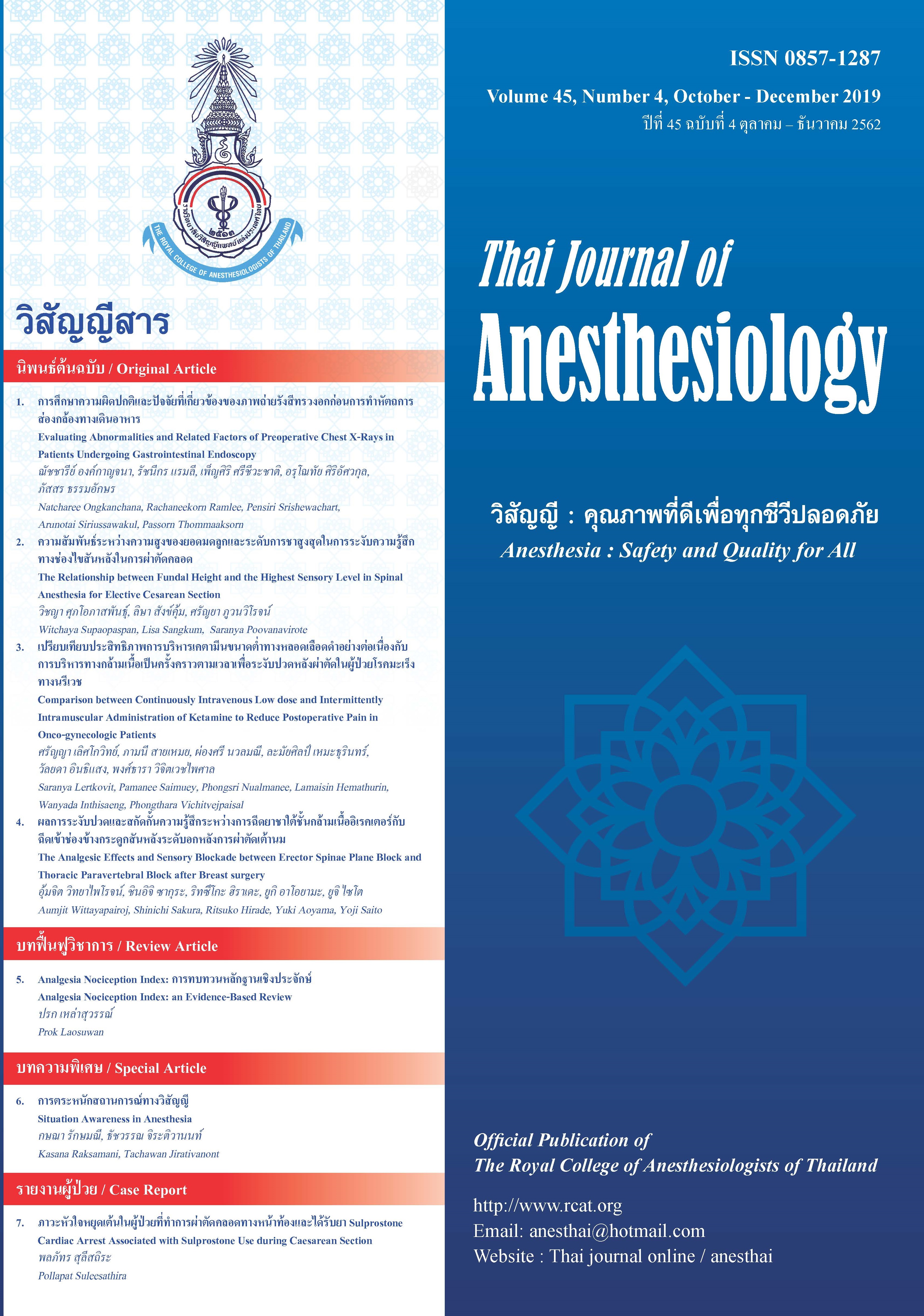Comparison between Continuously Intravenous Low Dose and Intermittently Intramuscular Administration of Ketamine to Reduce Postoperative Pain in Onco-gynecologic Patients
Main Article Content
Abstract
Introduction: Ketamine, known as general anesthetic
drug and short acting analgesic drug during operation,
helps to reduce the requirement of postoperative morphine
and its side effects.
Objective: to compare postoperative analgesia of low
dose ketamine administered by intermittently intramuscular
and continuously intravenous during anesthesia in
onco-gynecologic setting.
Materials and methods: Forty patients undergoing
onco-gynecologic surgery were randomized into
intravenous (IV) and intramuscular (IM) groups. During
induction of anesthesia, all patients received ketamine 0.5
mg/kg intravenously. Then, ketamine 0.25 mg/kg/hr
continuously to IV groups and 1 mg/kg were administered
intermittently intramuscular every 1 hour to IM groups.
In the recovery room, participants manipulate their pain
with morphine via PCA pump. Time to first morphine
requirement, morphine accumulation in 24 hours and its
side effects were recorded.
Results: Time to first morphine requirement is not different
between groups although there is a trend longer for the
intramuscular group (87.0±122.9 min vs 37.0±56.6 min,
p = 0.173). Morphine accumulation in 24 hours and its side
effects were also not different.
Conclusion: Low dose ketamine administered by
intermittently intramuscular during anesthesia provided
postoperative analgesia equally to continuously
intravenous in onco-gynecologic setting.
Article Details
References
ketamine in the management of acute postoperative pain: a
review of current techniques and outcomes. Pain 1999;82:
111-25.
2. Saxena D, Dixit A, Kumar N, Arya B, Sanwatsarkar S,
Bhandari S. Efficacy of low-dose ketamine as sole analgesic
agent in maintaining analgesia and intraoperative
hemodynamics during laparoscopic gynecological surgeries.
Anesthesia Essays and Researches 2017;11(2):385-9.
3. Parikh B, Maliwad J, R Shah V. Preventive analgesia: effect
of small dose of ketamine on morphine requirement after
renal surgery. J Anaesth Clin Pharmacol 2011;27(4):485-88.
4. Bicer F, Eti Z, Saracoglu KT, Altun K, Gogus FY. Dose the
method and timing of intravenous ketamine administration
affect postoperative morphine requirement after major
abdominal surgery? Turk J Anaesth Reanim 2014;42:320-5.
5. Loftus RW, Yeager MP, Clark JA, et al. Intraoperative
ketamine reduces perioperative opiate consumption in opiate
-dependent patients with chronic back pain undergoing back
surgery. Anesthesiology 2010;113(3):639-46.
6. Cengiz P, Gokcinar D, Karabeyoglu I, Topcu H, Cicek GS,
Gogus N. Intraoperative low-dose ketamine infusion reduces
acute postoperative pain following total knee replacement
surgery: a prospective, randomized double-blind placebocontrolled
trial. J Coll Physicians Surg Pak 2014;24(5):299-
303.
7. Menigaux C, Fletcher D, Dupont X, et al. The benefits of
intraoperative small-dose ketamine on postoperative pain
after anterior cruciate ligament repair. Anesth Analg 2000;
90:129-35.
8. Hassan MRA, Tang SSP, Yahya N, Teo R, Zainuddin K,
Manap NA. Effects of intraoperative low dose ketamine
infusion on postoperative morphine consumption. Anesth
Analg 2016;123(3S):445. (Abstract).
9. Avidan MS, Maybrier HR, Abdallah AB, et al. Intraoperative
ketamine for prevention of postoperative delirium or pain
after major surgery in older adults: an international,
multicenter, double-blind, randomized clinical trial. Lancet
2017;15:267-75.
10. Tuchscherer J, McKay WP, Twagirumugabe T. Low-dose
subcutaneous ketamine for postoperative pain management
in Rwanda: a dose-finding study. Can J Anaesth 2017;64:
928-34.
11. Launo C, Bassi C, Spagnolo l, et al. Preemptive ketamine
during general anesthesia for postoperative analgesia in
patient undergoing laparoscopic cholecystectomy. Minera
Anestesiol 2004;70:727-38.
12. Thomas M, Tennant I, Augier R, Gordon-Strachan G, Harding
H. The role of pre-induction ketamine in the management of
postoperative pain in patients undergoing elective
gynaecological surgery at the university hospital of the West
Indies. West Indian Med J 2012;61(3):224-9.
13. Dich-Nielsen JO, Svendsen LB, Berthelsen P. Intramuscular
low-dose ketamine versus pethidine for postoperative pain
treatment after thoracic surgery. Acta Anaesthesiol Scand
1992;36:583-87.
14. Grant IS, Nimmo WS, Clements JA. Pharmacokinetic and
analgesic effects of I.M. and oral ketamine. Br J Anaesth
1981;53:805-10.
15. Himmelseher S, Durieux ME. Ketamine for perioperative pain
management. Anesthesiology 2005;102(1);211-20.
16. Schwenk ES, Viscusi ER, Buvanendran A, et al. Consensus
guidelines on the use of intravenous ketamine infusion for
acute pain management from the American society of
regional anesthesia and pain medicine, the American
academy of pain medicine, and the American society of
anesthesiologists. Reg Anesth Pain Med 2018;43(5):1-11.
17. Sanansilp V. Acute postoperative pain management. In:
Phakanrattana U, Sanansilp V, Suksompong S, Toomtong P,
editors. Siriraj textbook of anesthesiology. 4th ed. Bangkok:
Department of Anesthesiology, Faculty of Medicine Siriraj
Hospital, Mahidol University 2013;47:781-808.

